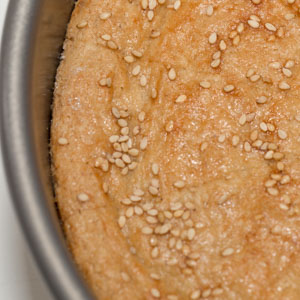Benne Shortbread

introduction
Famous for the short, sweet, compact crumb created when whole butter, flour, and sugar lock in a mortal embrace and brown to appealing crispness, shortbread boasts a limited ingredient integrity threshold like no other. It is, quite simply, a wonder of the minimal, dispossessed of even a single drop of liquid—save those secreted by its butter. We wanted to bring the big, seductive flavor payoff of bennecake flour to a shortbread formula, and we did—with an allowance or two.
Bennecake, you may recall from previous baking adventures with us, refers to the dry remnants of our West African benne seeds left in the press after oil has been extracted from their casings. These remnants are subsequently milled to a flour we call bennecake. And bennecake, it turns out, delivers pretty spectacular results to a shortbread recipe, carrying an overall impression of nutty, haunting caramel to the other ingredients while demonstrating a unique textural flexibility whereby light, flaky crispness succumbs to a seductive chew within a single wedge. We also opened the crumb a touch with an ounce of ground pecans (an ingredient toward which benne shows natural flavor affinity).
If we are forthright, this benne “shortbread” violates the very definition of the shortbread we just extolled. It does not hew to rigid ingredient minimalism or feature the uniform crisp-i-tude of traditional shortbread. But alternate descriptors didn’t quite touch the magic of these benne wedges either. Don’t throw the benne out with the bathwater until you’ve tasted these shortbread—er, cookies.
Baking Notes
This dough has a dryish feel. Even compressed in the palm of the hand, it barely registers as a dough at all. It is also, frankly, difficult to spot exactly when this shortbread is done using traditional visual clues. The dough doesn’t rise or spread or crack. If you go long, obviously, the surface will continue to color. If you take the cookies out too soon, their tips will be crumbly, not chewy. An oven thermometer would make a worthy ally in pursuit of perfection—as will your attention to time and technique.
equipment mise en place
For this recipe, you will need a digital kitchen scale, a food processor, an 8-inch round cake pan, a small offset spatula or spoon, a pastry brush, a paring knife, and a wire rack.
-
-
5ounces (1 cup) Anson Mills Colonial Style Fine Cloth-Bolted Pastry Flour
-
2.2ounces (½ cup) Anson Mills New Crop Heirloom Bennecake Flour
-
3.5ounces (½ cup) sugar, plus 1 teaspoon for sprinkling
-
½teaspoon fine sea salt
-
1ounce (¼ cup) coarsely chopped pecans
-
5ounces (10 tablespoons) unsalted European-style butter, cut into ½-inch pieces, cool room temperature
-
1egg white, lightly beaten
-
2teaspoons Anson Mills Sea Island Benne Seeds
-
-
Adjust the oven racks to the lower- and upper-third positions and heat the oven to 325 degrees.
-
Turn the flours, the 3.5 ounces (½ cup) sugar, the salt, and the pecans into a food processor and pulse until the pecans are finely ground, about 15 one-second pulses. Distribute the butter over the dry ingredients and pulse until the mixture looks like sand (fig. 2.1), about 10 one-second pulses. Run the processor just until the ingredients come together in a soft dough (fig. 2.2), about 10 seconds.
-
Turn the dough into an ungreased 8-inch round cake pan and press it into an evenly thick layer with a small offset spatula or the back of a spoon. Brush the surface with egg white, sprinkle with the benne seeds, and press the seeds lightly into the dough with the offset spatula or spoon. Sprinkle with the 1 teaspoon sugar, and then score the surface of dough into 12 wedges with a paring knife (fig. 3.1). Bake on the lower oven rack for 20 minutes, and then transfer the pan to the upper rack and continue to bake until light golden brown (fig. 3.2), about 10 minutes more. Place the pan on a wire rack and let cool completely.
-
Using a paring knife, cut through the score marks to divide the shortbread into wedges. Lift each wedge from the pan with a small offset spatula. (The cookies will keep in an airtight container for up to 1 week at room temperature, but we make no predictions as to their longevity.)
-
-
2.1

-
2.2

-
-
-
3.1

-
3.2

-